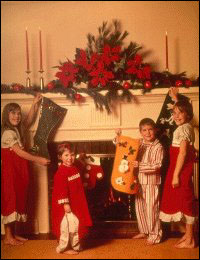Part 1 圣诞节的来历
Part 2 The History of Santa Claus 圣诞老人的来历
Part 3 The Christmas Tree 圣诞树
Part 4 Christmas Stockings and Christmas Cards 圣诞袜和圣诞卡
Part 5 Christmas Party 庆祝圣诞节
Part 4 Christmas Stockings and Christmas Cards 圣诞袜和圣诞卡
There was a kindly nobleman whose wife had died of an illness leaving the nob leman and his three daughters in despair. After losing all his money in useless and bad inventions the family had to move into a peasant's cottage, where the daughters did their own cooking, sewing and cleaning.
leman and his three daughters in despair. After losing all his money in useless and bad inventions the family had to move into a peasant's cottage, where the daughters did their own cooking, sewing and cleaning.
When it came time for the daughters to marry, the father became even more depressed as his daughters could not marry without dowries, money and property given to the new husband's family.
One night after the daughters had washed out their clothing they hung their stockings over the fireplace to dry. That night Saint Nicholas, knowing the despair of the father, stopped by the nobleman's house. Looking in the window Saint Nicholas saw that the family had gone to bed. He also noticed the daughters stockings. Inspiration struck Saint Nicholas and he took three small bags of gold from his pouch and threw them one by one down the chimney and they landed in the stockings.
The next morning when the daughters awoke they found their stockings contained enough gold for them to get married. The nobleman was able to see his three daughters marry and he lived a long and happy life.
Children all over the world continue the tradition of hanging Christmas stockings. In some countries children have similar customs, in France the children place their shoes by the fireplace, a tradition dating back to when children wore wooden peasant shoes.
In Holla nd the children fill their shoes with hay and a carrot for the horse of Sintirklass. In Hungary children shine their shoes before putting them near the door or a window sill.
nd the children fill their shoes with hay and a carrot for the horse of Sintirklass. In Hungary children shine their shoes before putting them near the door or a window sill.
Italian children leave their shoes out the night before Epiphany, January 5, for La Befana the good witch. And in Puerto Rico children put greens and flowers in small boxes and place them under their beds for the camels of the Three Kings.
关于圣诞节在火炉边悬挂圣诞袜也有一个有趣的传说。很久很久以前有一个心地善良的贵族,他的妻子因病去逝,抛下他和他的三个女儿。这个贵族尝试了不少发明,都失败了,但也因此耗尽了钱财,所以他们不得不搬到一家农舍里生活,他的女儿们也只得亲自烧煮、缝纫和打扫。
一晃几年过去,女儿们陆续到了出嫁的年龄,父亲却变得更加沮丧,因为他没钱给女儿们买嫁妆。一天晚上,女儿们洗完衣服后将长统袜挂在壁炉前烘干。圣人Nicholas知道了她们父亲的境况后,就在那天晚上,来到她们的家门前。他从窗口看到一家人都已睡着了,同时也注意到了女孩们的长统袜。随即,他从口袋里掏出三小包黄金从烟囱上一个个投下去,刚好掉在女孩们的长统袜里。
第二天早上,女儿们醒来发现她们的长统袜里装满了金子,足够供她们买嫁妆了。这个贵族也因此能亲眼看到他的女儿们结婚,从此便过上了幸福快乐的生活。后来,世界各地的孩子们都继承了悬挂圣诞袜的传统。有些国家的孩子则有其它类似的风俗,如在法国,孩子们将鞋子放在壁炉旁等等。
The custom of sending Christmas cards started in Britain in 1840 when the first 'Penny Post' public postal deliveries began. (Helped by the new railway system, the public postal service was the 19th century's communication revolution, just as email is for us today.) As printing methods improved, Christmas cards were produced in large numbers from about 1860. They became even more popular in Britain when a card could be posted in an unsealed envelope for one half-penny - half the price of an ordinary letter.
Traditionally, Christmas cards showed religious pictures - Mary, Joseph and baby Jesus, or other parts of the Christmas story. Today, pictures are often jokes, winter pictures, Father Christmas, or romantic scenes of life in past times.
圣诞树和圣诞花卉,一般用来装饰家庭居室,也有用圣诞花卉作礼品赠亲友的。圣诞贺卡则完全是节日赠品,表达自己对别人的良好祝愿。
圣诞卡的诞生也有很多种说法,一八六四年,英国的阿尔巴特亲王特别推广这件事,就印制了一千张圣诞图画的圣诞卡,开始发售。到一八六五年,印刷的圣诞卡,开始大量销售了。首先是由德国绘画彩色的石版工厂印制以后,运送到英国去,正式发售,再从英国传到世界的各地,于是寄送 圣诞卡的风俗,渐渐流行起来。当初圣诞卡的寄送,只通行在基督徒之间,到了二十世纪初,普遍风行,不论是不是基督信徒,都以圣诞卡向亲友祝福,和恭贺新年。
圣诞卡的风俗,渐渐流行起来。当初圣诞卡的寄送,只通行在基督徒之间,到了二十世纪初,普遍风行,不论是不是基督信徒,都以圣诞卡向亲友祝福,和恭贺新年。
另一种说法:圣诞卡始于一八四四年。当时,英国维多利亚女皇和Albert太子在伦敦的温莎堡里庆祝圣诞节,邀请王族儿童入宫参加宴会,请柬上印有祝贺的词句。欧洲人从此纷纷仿效,用这种写上祝贺词的卡片来互相祝贺圣诞和新年。
圣诞卡片从早期的单色印刷至今日的色音俱全,不但让收到卡片的人大饱眼福,而且还大饱耳福,一张张会发出声音的圣诞卡使整个节日的气氛更加浓厚。
圣诞节这天,指出天下一家世界大同的理想,只有以和平与仁爱的言行达成。寄赠圣诞卡,除表示庆贺圣诞的喜悦外,就是向亲友祝福,以表想念之情。以前圣诞卡的画面,多半与耶稣圣诞有关;现在的图样,真是花样百出,多采多姿。如果你有亲友在遥远的地方,平日忙于工作很少联系,那么赶紧趁圣诞节寄上一张圣诞卡,表达你的想念和祝福吧。我们在网页上提供了一些写圣诞贺卡祝词的例子,大家在写圣诞卡的时候可以参考一下。
